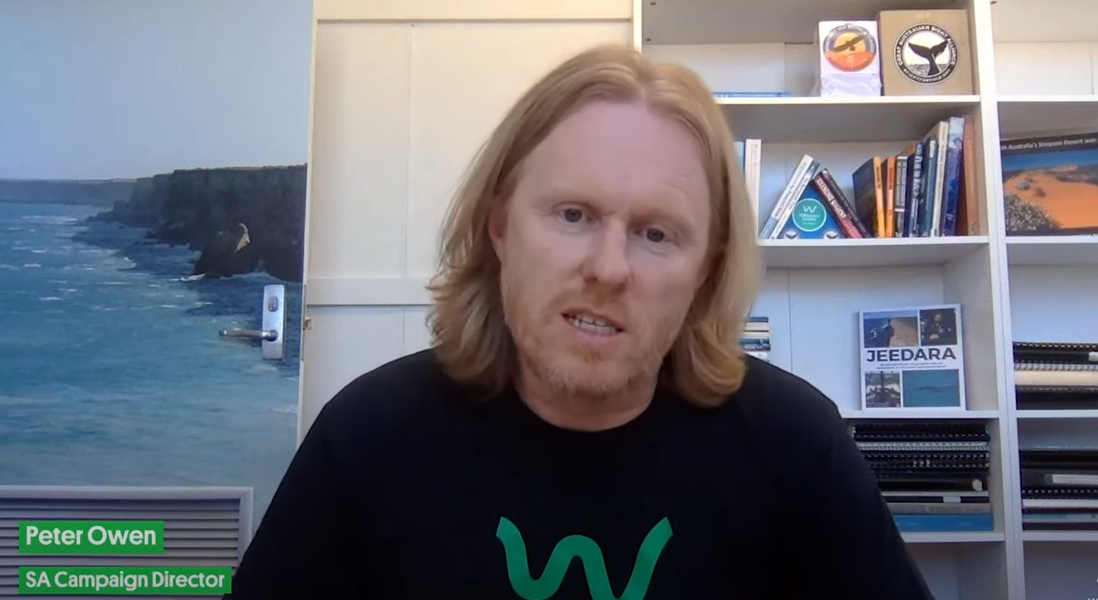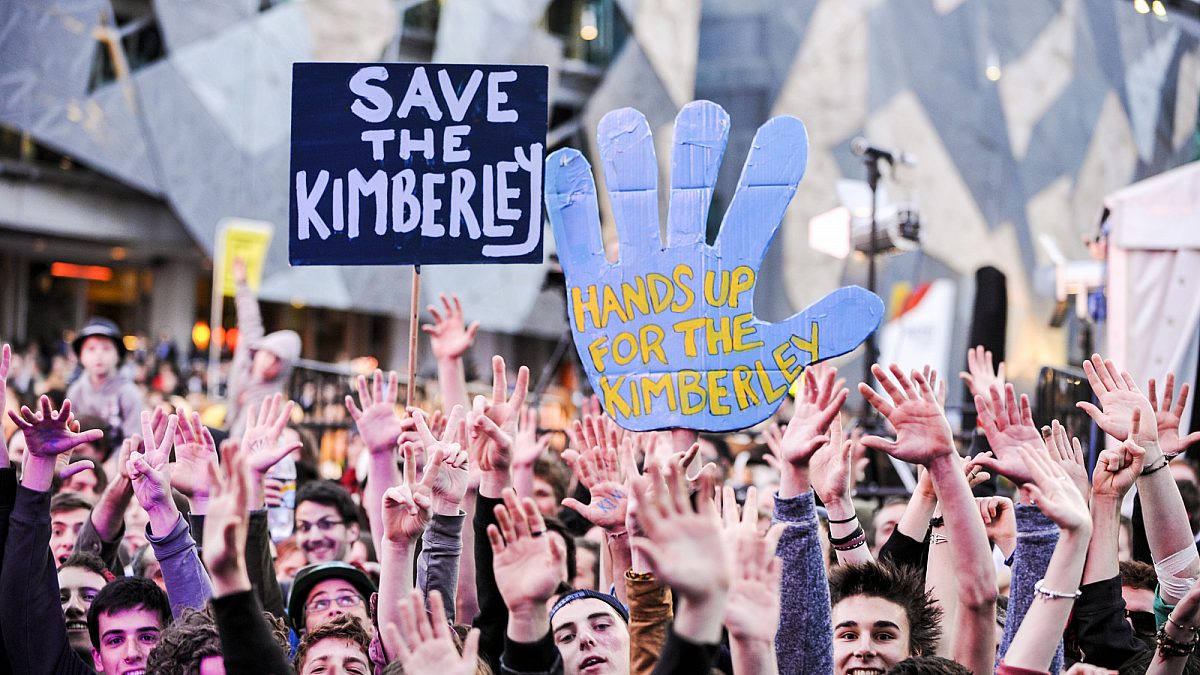
Environmental campaign wins
When it comes to protecting Australia’s environment, it can seem like the odds are stacked against us. But take heart, because we've been here before—and come out on top.
Together, we've made some extraordinary progress for nature over the last 40 years. Here's a few examples of what our supporters have achieved—starting in the 1970s, with a wild Tasmanian river.
Franklin River, Tasmania
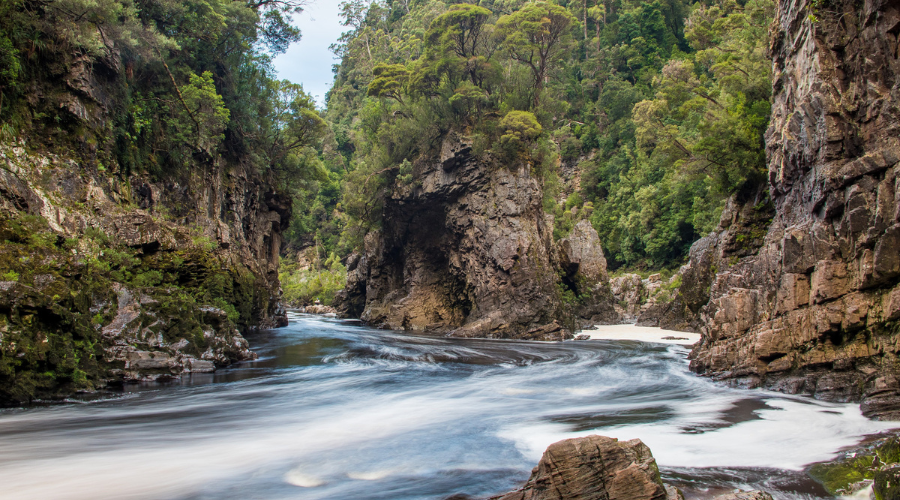
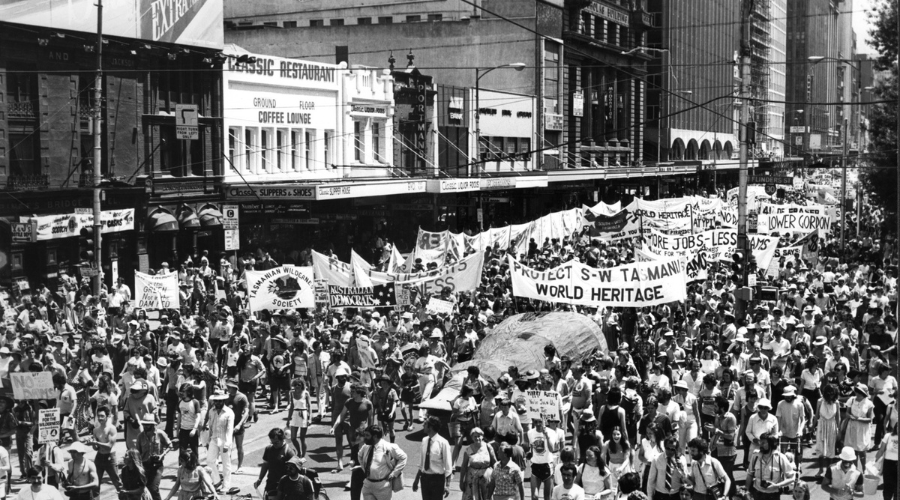
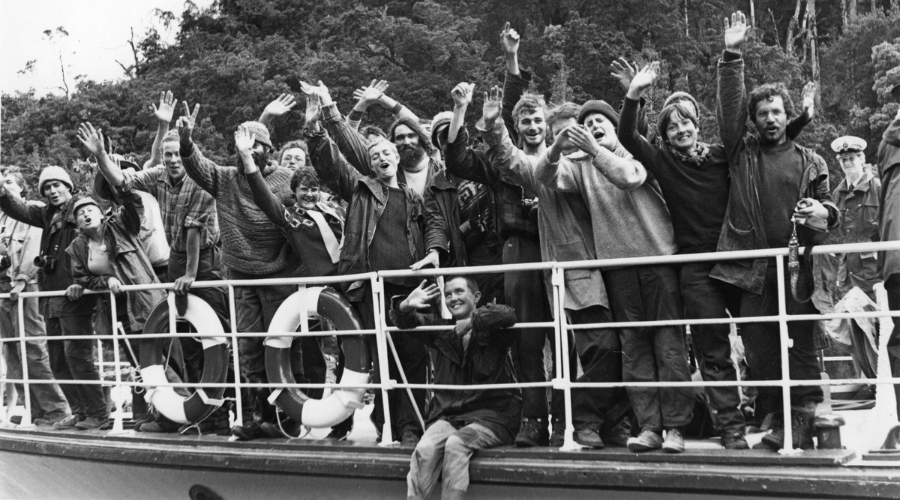
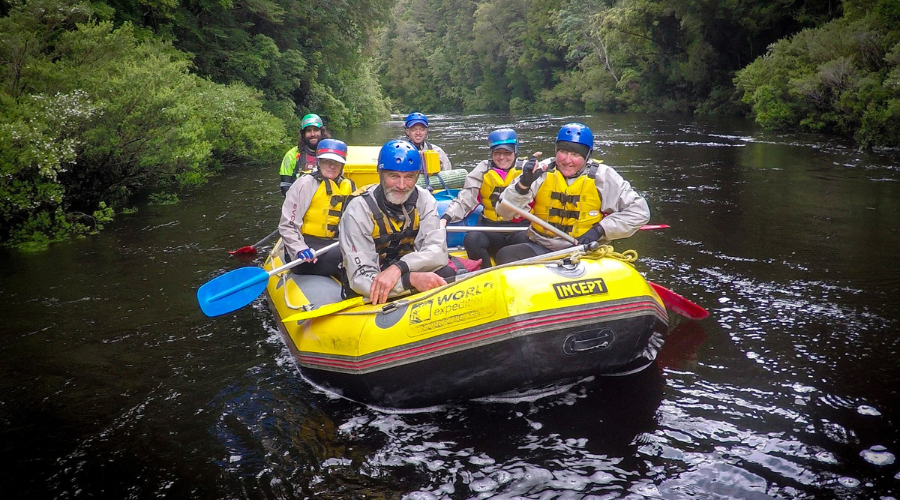
The mighty Franklin River, still flowing wild and free.
15,000 people rally in Melbourne for the protection of Tassie's wild rivers ahead of the 1983 federal election.
Detainees from the Franklin Blockade aboard a cruiser hired by police to ferry arrested protesters across to Strahan.
White water rafters enjoying the unspoilt Franklin River today.
1978–1983: In the early 1970s, a historic but ultimately unsuccessful campaign emerged to prevent the flooding of beautiful Lake Pedder in South West Tasmania for hydro-electricity. The movement to save Tasmania’s Franklin and Gordon rivers from another huge hydro-electric development grew out of the Pedder campaign and defined a generation, giving rise to The Wilderness Society as you know us today. Over 1,000 people were arrested in the months-long Franklin blockade, and many more travelled from all over Australia to take part in our peaceful protests.
What was at stake: Tasmania has some of the most pristine wilderness areas in Australia, and the Franklin and Gordon rivers are no exception. In early 1981, caves with evidence of Aboriginal occupation dating back 20,000 years were also found in the area which would be flooded if the dam were to be built. The entire area was included on the UNESCO World Heritage list on 14 December 1982, which was chosen as the start date for the Franklin blockade.
What we were up against: In opposition was a pro-dam conservative State Government, selling Tasmanians the promise that the hydro-electric scheme—which would destroy forever a site of unspoilt natural and cultural heritage—would generate jobs and economic growth. Successive State Governments had for decades promoted hydro-powered industrialisation as Tasmania’s only economic future.
How we did it: Led by a young doctor, Bob Brown, the fight to save the Franklin is considered one of the most significant environmental campaigns in Australian history. After years of large protests across the country and non-violent occupation of the dam site involving thousands of Australians, the Federal Government of Malcolm Fraser was brought down at the 1983 election—the new government, under Bob Hawke, had promised to stop the dam from being built.In the lead up to the election, we took out full-page ads in national newspapers, featuring Peter Dombrovskis’ famous colour photo of Rock Island Bend on the Franklin river, with the caption: Could you vote for a party that will destroy this?
Our volunteers letterboxed houses, distributed leaflets and talked with voters in marginal electorates, and 13,000 people staffed polling booths in support of the Franklin on election day. After the election, a legal battle between the Federal Government and Tasmanian Government ensued, resulting in the High Court ruling in July 1983 that “there shall be no dam on the Franklin River".
This landmark case confirmed the Federal Government’s power to intervene and protect sites listed as World Heritage. Because of our people-powered movement, the irreplaceable Franklin River and its surrounds have been protected and enjoyed by millions ever since.
Munga-Thirri—Simpson Desert, South Australia
2010-2021: The biggest national park in Australia has finally been announced! Covering 3.6 million hectares, it is almost four times the size of the famous Yellowstone National Park in the US. This is a grand initiative, on a scale we have been advocating for from the start. It is a significant step towards a huge conservation corridor in the heart of Australia, allowing endangered animals and plants to move and adapt to a rapidly changing climate. But to achieve this, the expansion of the fossil fuel industry into the region must be stopped.
What was at stake: In 2010, the Wilderness Society South Australia travelled into the Munga-Thirri—Simpson Desert to document its wilderness values. We were lucky to be there after a big rain. Every once in a while, rain transforms the swales between the sand dunes into temporary wetlands. Thousands of birds flock here from across Australia to feed and breed. Then native flowers burst into colour across the burnt-orange sand—a beautiful garden that seems to stretch into infinity.
This remarkable landscape spans millions of hectares across the heart of Australia. It protects unbroken sand ridges and ecologically vital wetlands like Kati Thanda—Lake Eyre. It's a sanctuary for unique plants and animals. And it's Country for First Nations people, who've been here for thousands of years.
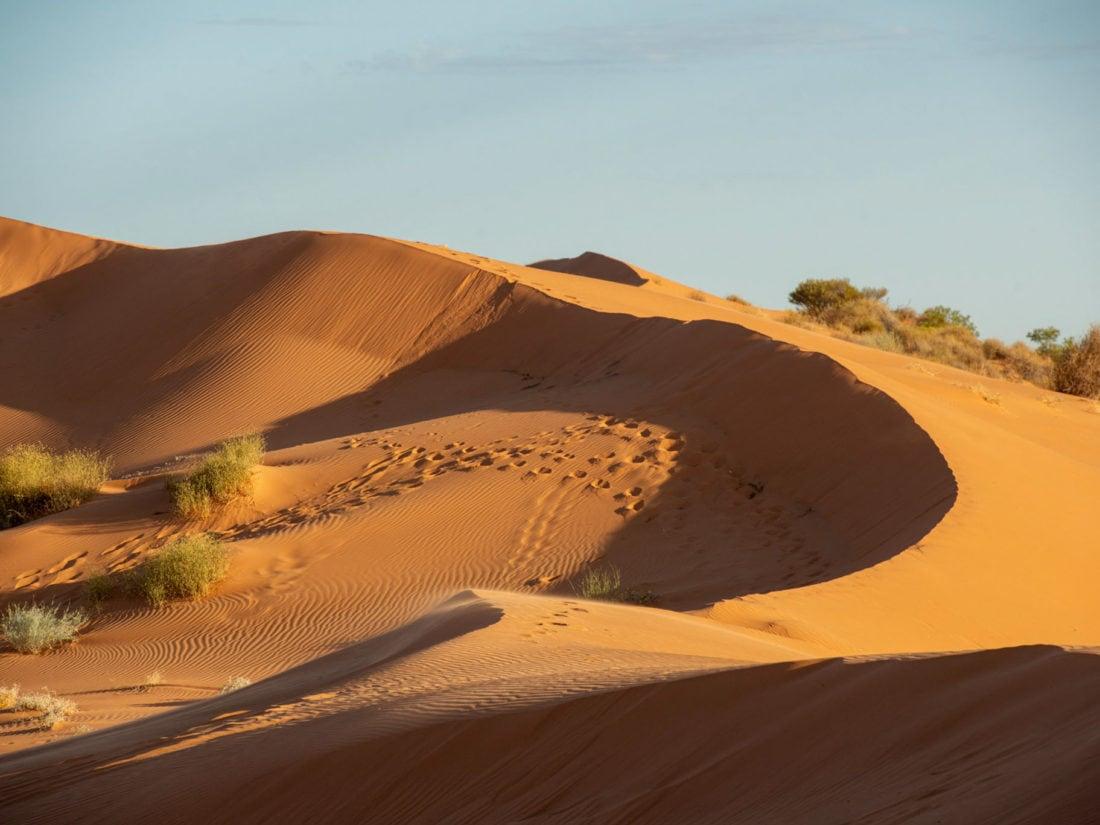
What we were up against: For over a decade, the Wilderness Society has been working to protect this globally important ecosystem. After our first expedition, the former South Australian government recognised the Simpson Desert as high quality wilderness. But just before the area could be officially proclaimed under the SA Wilderness Protection Act, 1992, fossil fuel exploration leases were issued across the region, essentially locking it up for the fossil fuel industry.
How we did it: We were able to convince the first companies who bought the leases to pull out, making it clear the community would not stand for mining in one of the most intact desert ecosystems the world has left. Sadly, in 2017, a multinational named Tri-Star Energy Company took up the leases in the Simpson. Then in 2020, when the country was in COVID lockdown, it announced its plans for exploration.
The Wilderness Society then met with Tri-Star to express our serious concerns with its proposal, as well as relevant government officials and Ministers. We held public meetings and ran a major community awareness program, including billboards around Adelaide.
On 25 November, 2021, Australia's largest ever national park in the Munga-Thirri—Simpson Desert was proclaimed by the South Australian Government.
James Price Point, Kimberley
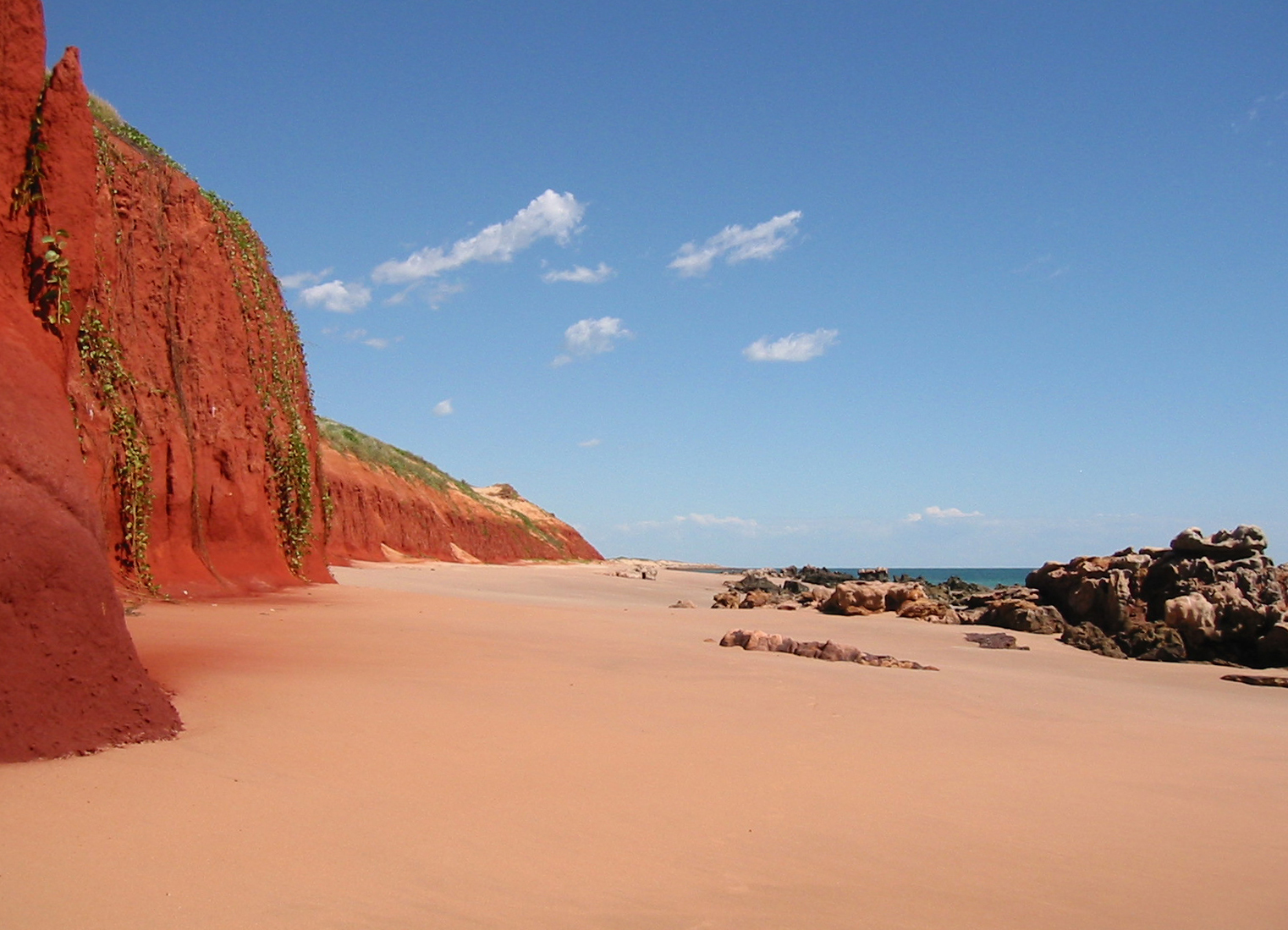
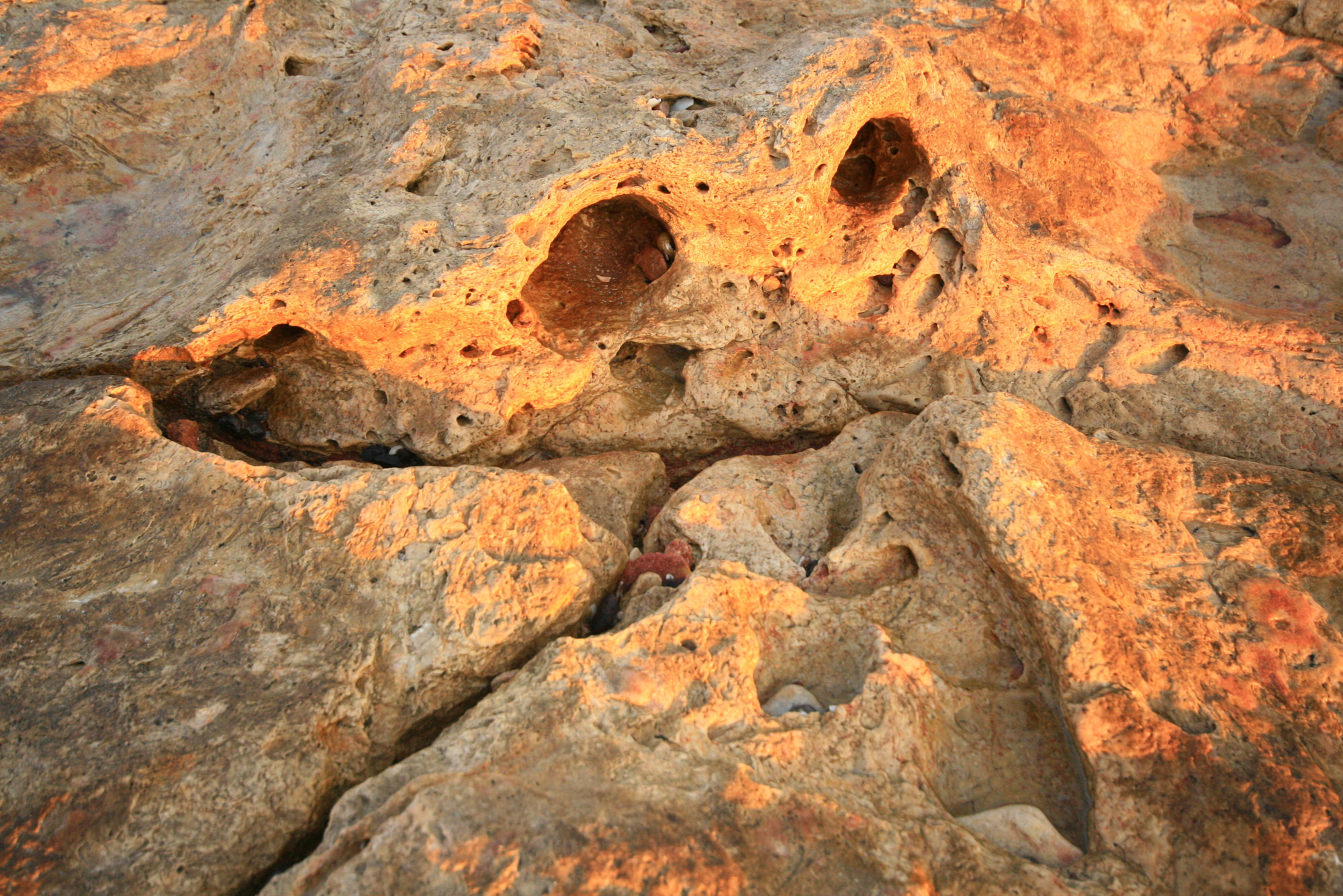
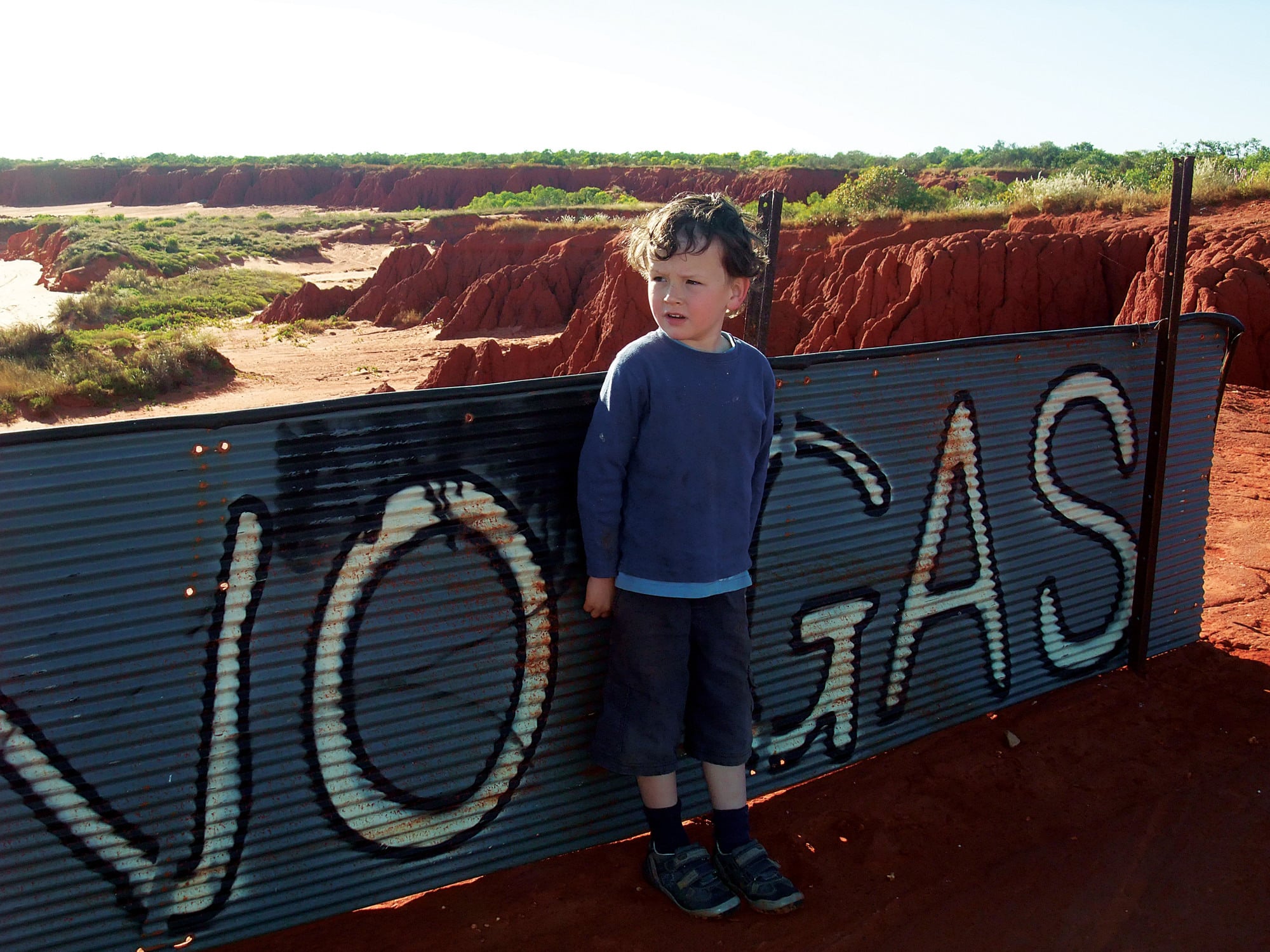
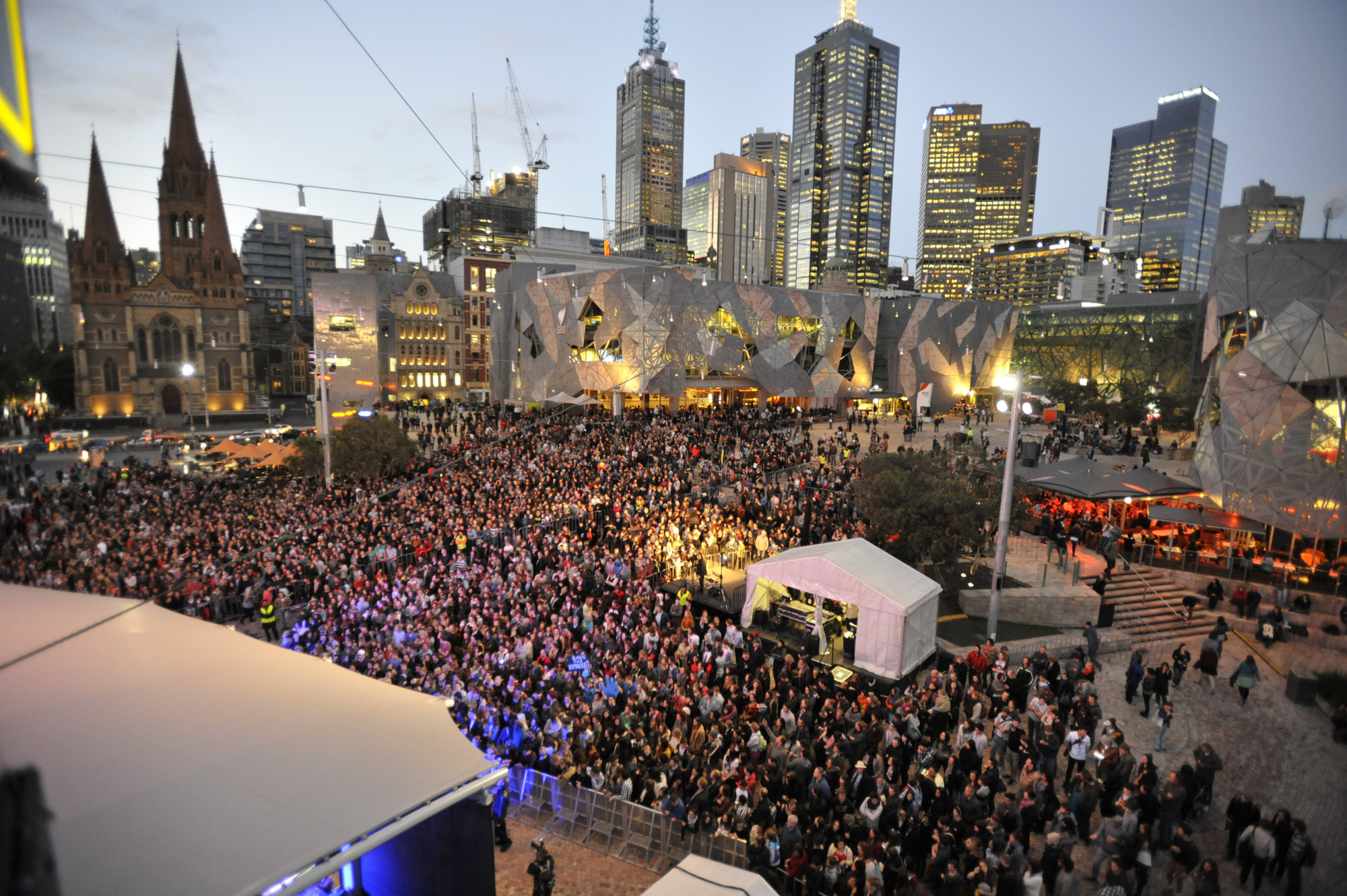
The bright red cliffs of James Price Point.
Dinosaur footprints at James Price Point.
A child stands next to a 'NO GAS' sign.
Concert for the Kimberley in Melbourne.
2008–2013: On the Kimberley coast, fifty kilometres north of Broome, we stood together with Traditional Owners and the Broome community to say 'no' to industrialisation, and the massive Browse liquefied natural gas (LNG) hub proposed for James Price Point was stopped in its tracks.
What was at stake: James Price Point (Walmadany) is part of one of the world’s longest pristine coastlines. With its striking red soil (‘pindan’) cliffs lining waters filled with life—fish, turtles, Dugongs, Humpback whales, corals and seagrasses—this was one place the polluting fossil fuel industry had to be kept away from. A study by the University of Queensland confirmed James Price Point also contains the largest collection of dinosaur footprints in the world, and the world's largest single print.
What we were up against: The proposed $45+ billion LNG hub involved a joint venture between global energy giants Woodside Petroleum, Royal Dutch Shell, BP, Chevron, Japan Australia LNG and BHP Billiton. It was backed to the hilt by the extremely pro-mining Western Australia Government led by Premier Colin Barnett, who personally chose James Price Point as the site for the LNG hub in 2008.
How we did it: The fight to save James Price Point took nearly six years. During this time, our supporters worked to raise the profile of the issue around Australia—from massive concerts in Melbourne to protest marches in Perth and Broome, people were engaged with the beauty of the Kimberley coast and what was at stake if it became industrialised.We supported local groups protesting at the James Price Point site—capturing their stories, feeding them to the media, and making sure politicians couldn’t ignore the issue. Finally, after many rallies, international corporate and investor lobbying, and legal battles—including a win in the Supreme Court of WA where we challenged the State Government's environmental approval of the project—the companies involved were forced to walk away.
The stark red cliffs, clean waters and cultural riches of Walmadany were saved, thanks to tens of thousands of Australians—many of whom may never visit this distant corner of our continent.
Great Australian Bight, southern Australia
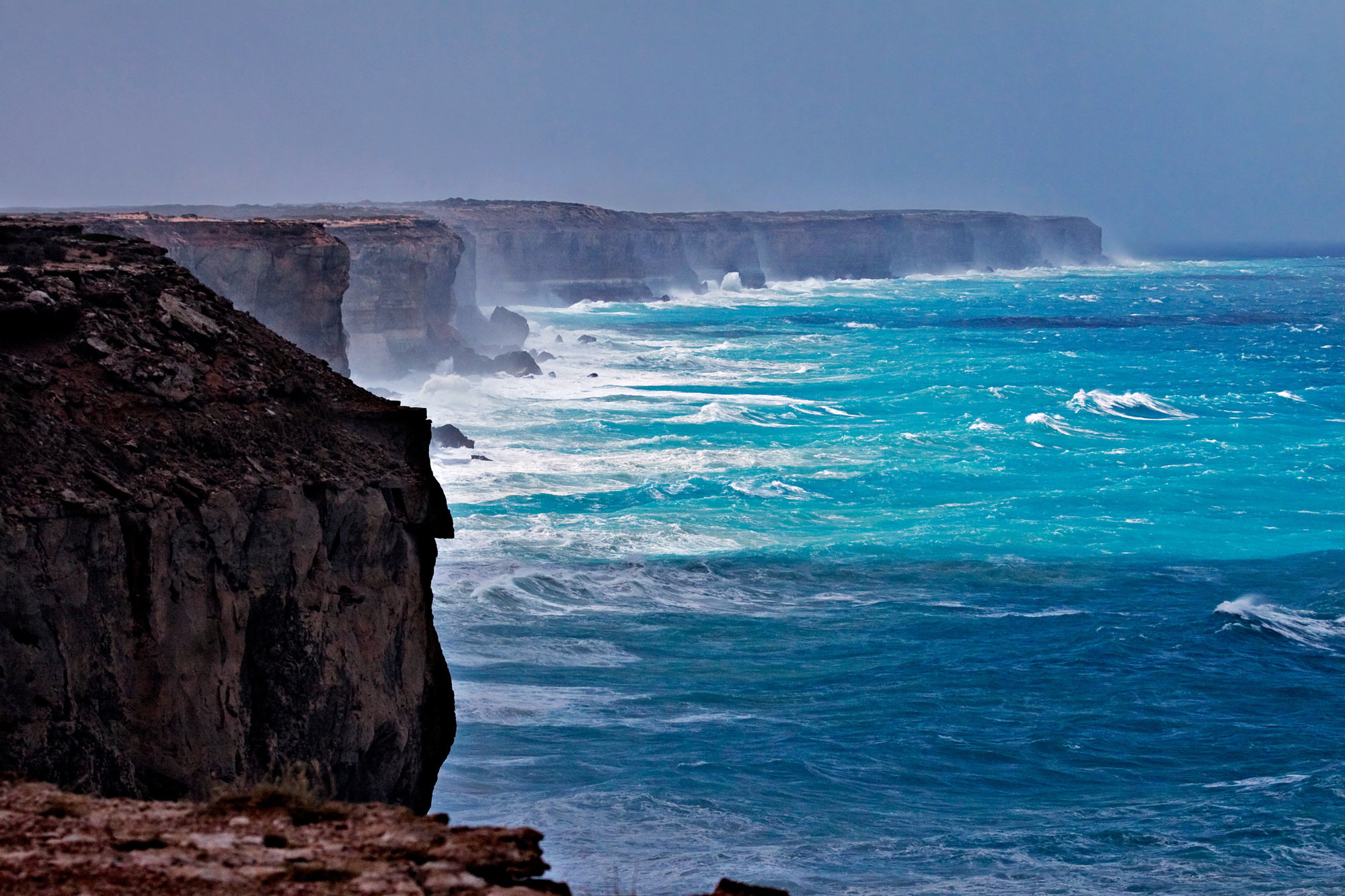
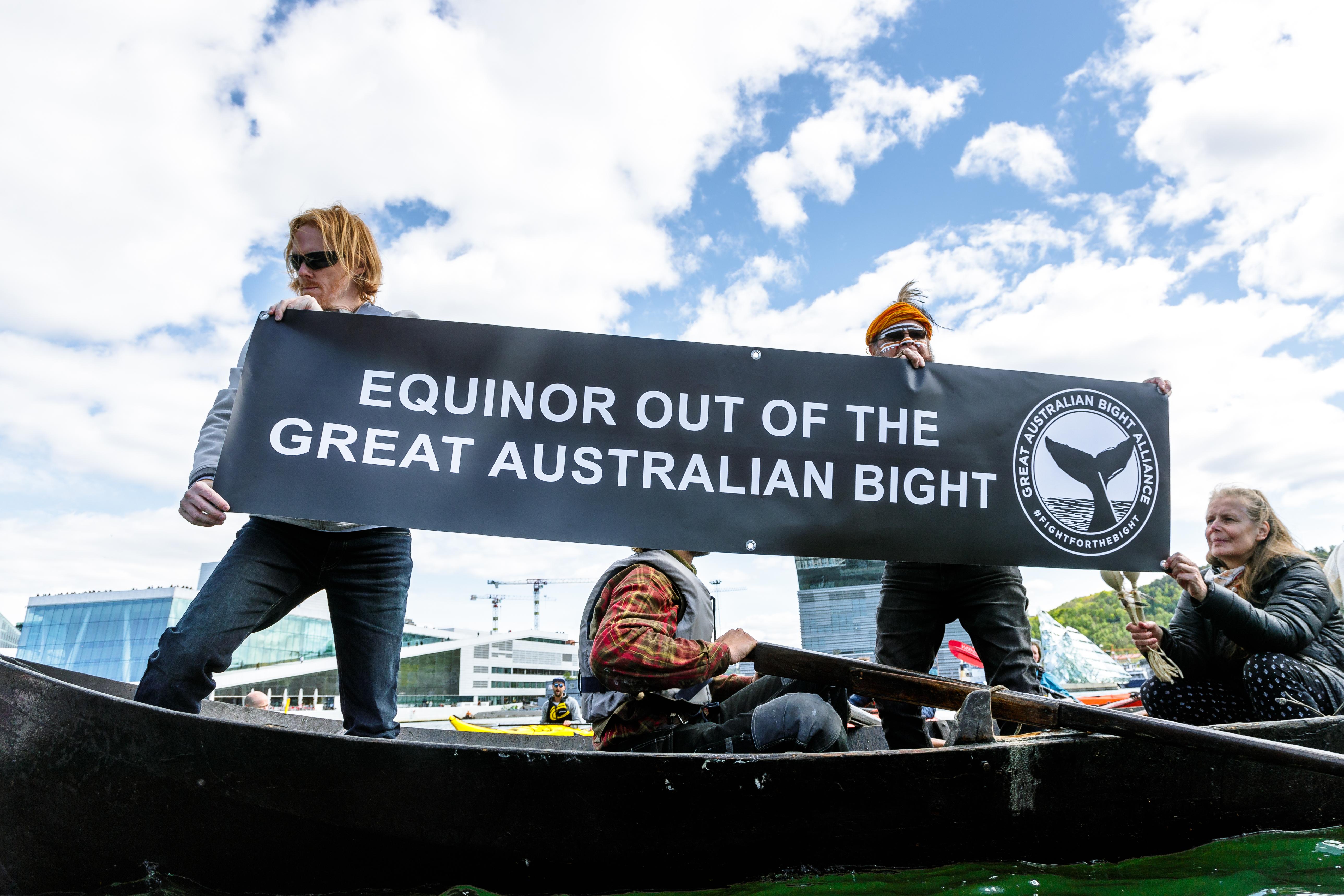
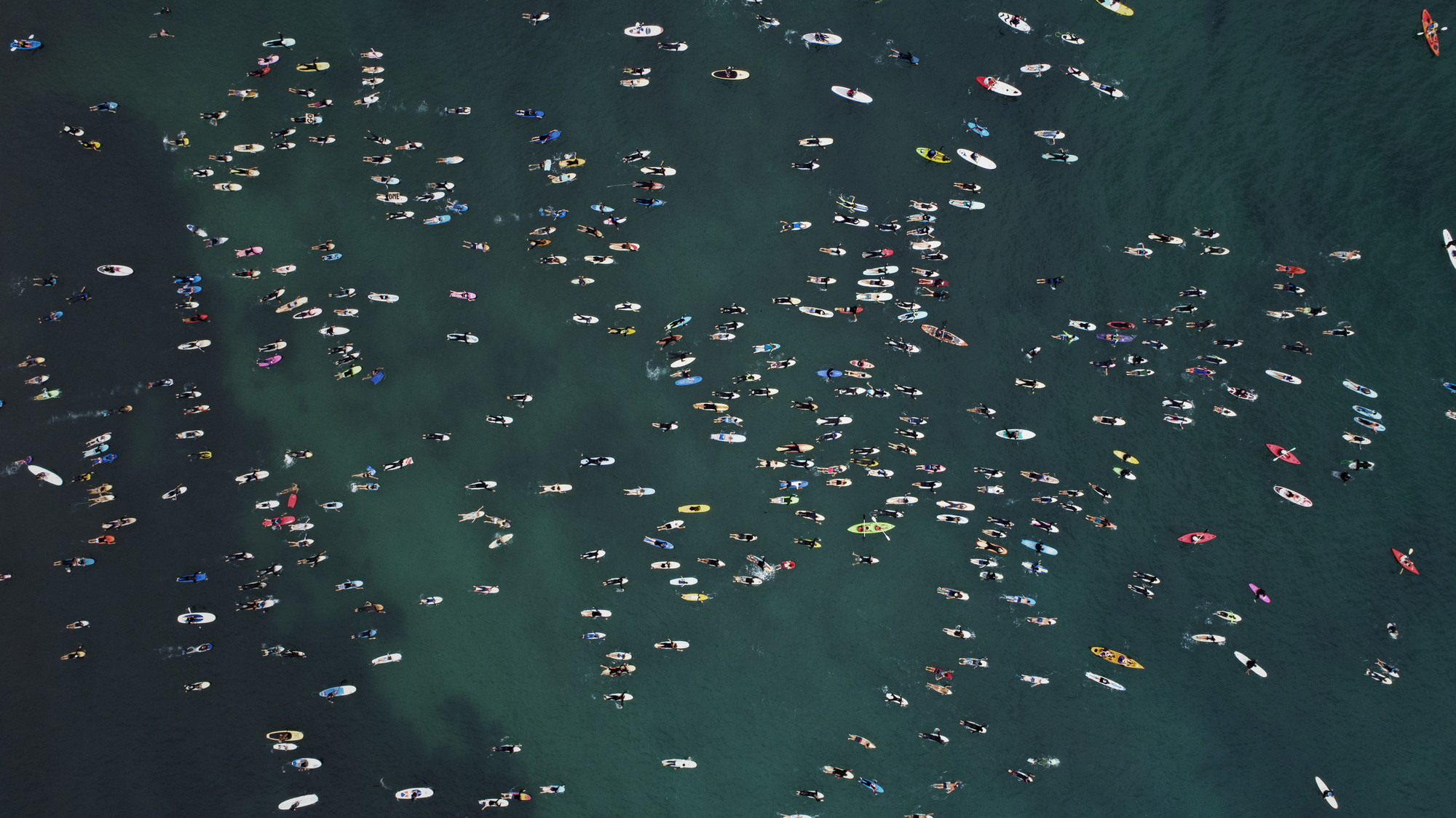
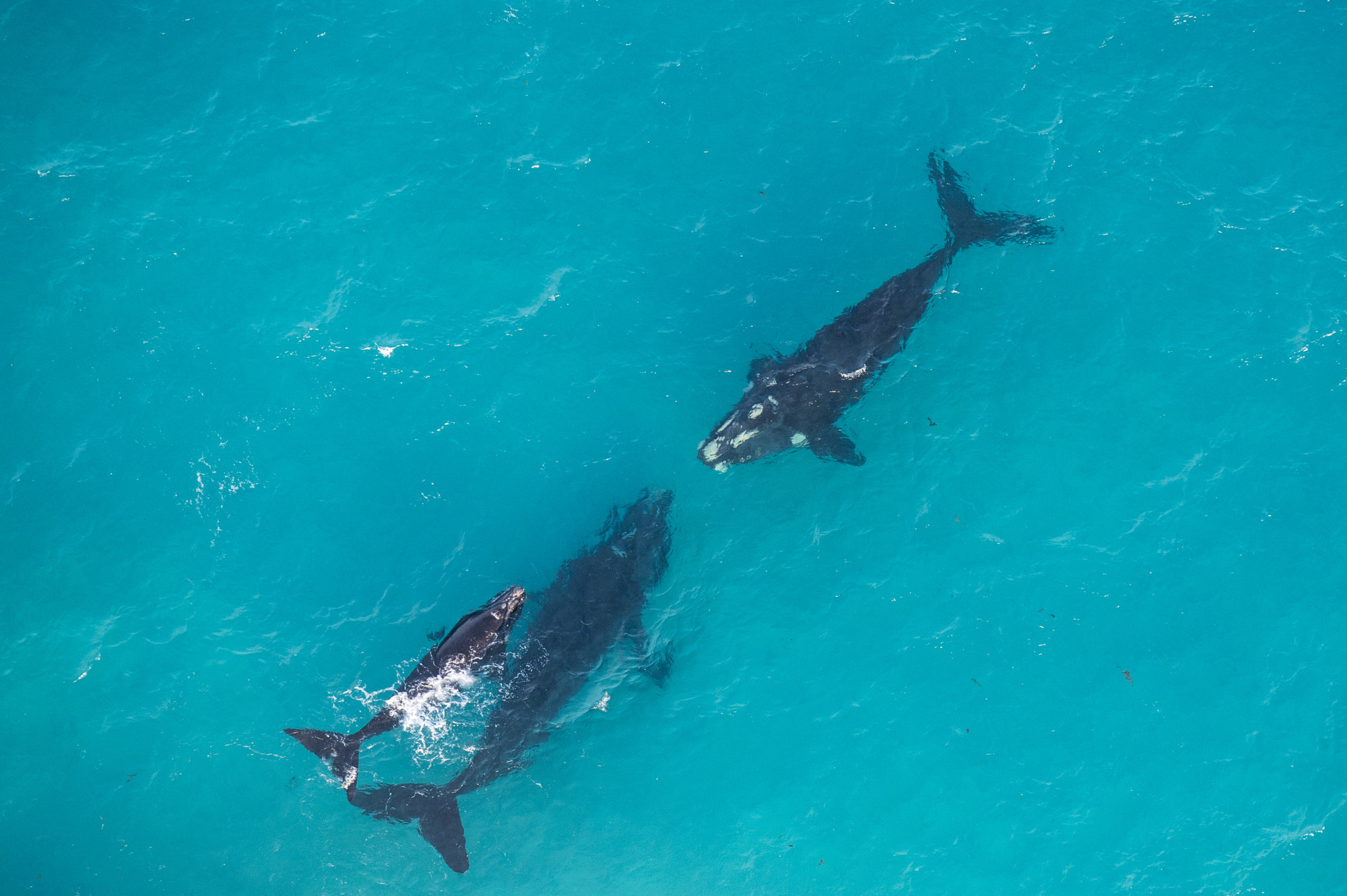
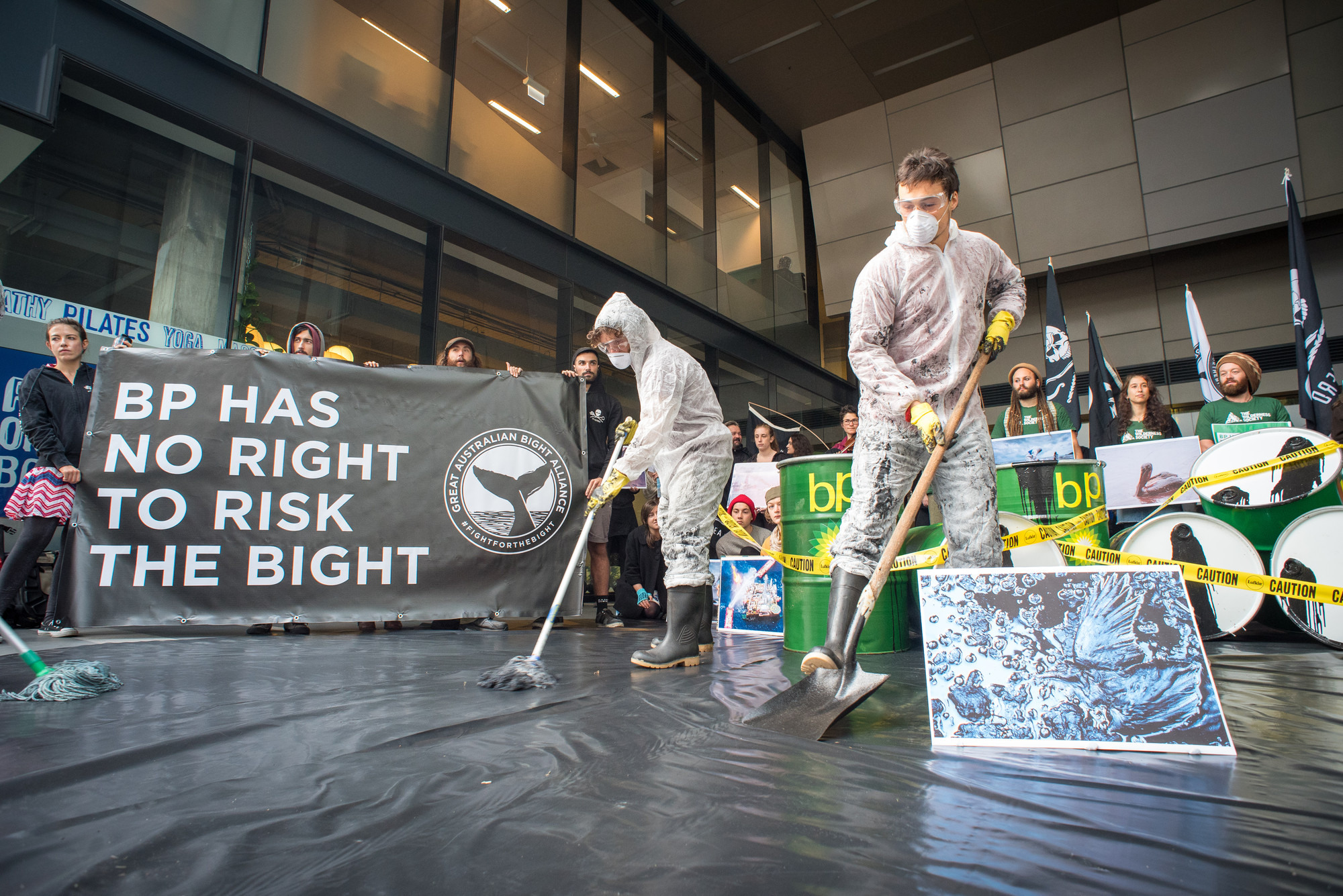
The rough and wild seas of the Great Australian Bight.
Bunna Lawrie & Wilderness Society SA Director Pete Owen in Norway.
A 'Paddle Out' event in Victor Harbor, SA. Image: Darren Longbottom
The Bight supports an abundance of life—including these southern right whales.
A Great Australian Bight Alliance oil spill action outside BP's AGM.
2015−present: Thanks to the pressure our campaign has built, we've already forced three Big Oil companies, BP, Chevron and Equinor, to pull the plug on plans to drill in the pristine waters of the Great Australian Bight. We won't stop until this thriving marine sanctuary is protected from the fossil fuel industry for good.
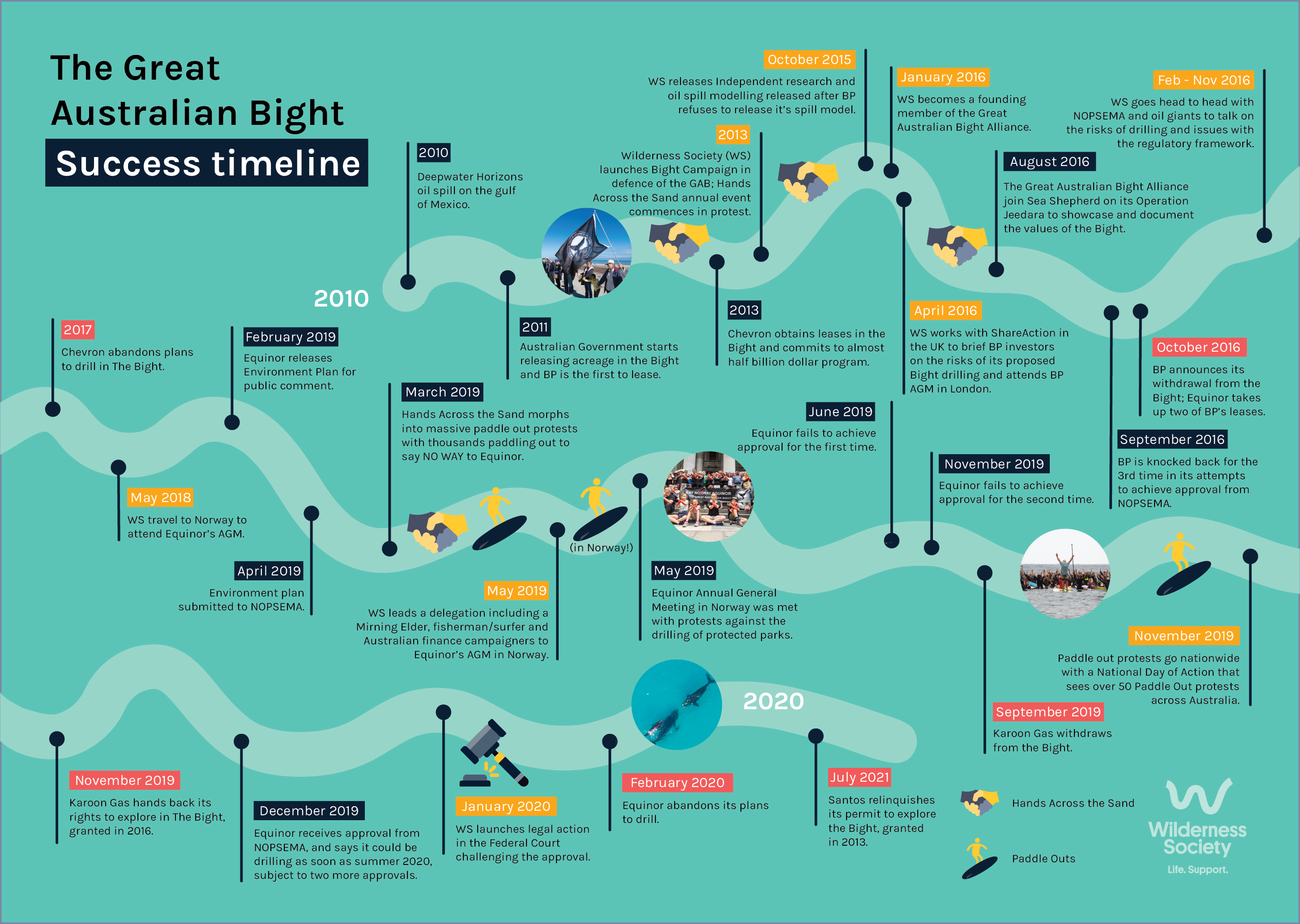
What’s at stake: The Great Australian Bight is a vital nursery for the protected southern right whale, home to endangered sea lions and more than 36 species of dolphins and whales. In fact, over 85% of the animals and plants found in the Bight are found nowhere else on Earth! Not only would an oil spill off our southern coastline affect wildlife and marine parks, it could devastate beach communities, fisheries and tourism.
What we’re up against: Big Oil companies believe that a large untapped oil basin lies beneath the Bight’s deep, rough seas. If tapped and burned, this oil would single-handedly blow Australia’s carbon budget... and our liveable climate.
What we’re doing: We've commissioned independent oil spill modelling to reveal to the Australian public what an oil spill on our shores might look like, and the results spell disaster. In May, we took the #fightforthebight all the way to Equinor's AGM in Norway to tell Equinor, the Norwegian Government and other shareholders that Australians won't stand for oil drilling in our pristine southern seas.Our delegation, which included Mirning Elder and Whale Songman Bunna Lawrie, generated enormous coverage in the Norwegian media. Back at home, our recent 'Paddle Out' protest events have drawn over 10,000 people across the country; 20 southern Australian councils have now passed motions raising their concerns with oil drilling in the Bight; and we managed to convince the Federal Government to promise an independent review of Equinor’s drilling plans.
In January 2020, we launched a legal case against oil and gas regulator NOPSEMA's approval of Equinor's Environment Plan. Subsequently, in February 2020 Equinor abandoned its plans to drill in the Bight.
And in July 2021, Santos became the latest company—like Equinor, BP and Chevron before it—to abandon its plans to deep sea drill for oil off our southern coastline in the face of community outrage. But we won't stop until this thriving marine sanctuary is protected from the fossil fuel industry for good.
Deforestation, Queensland
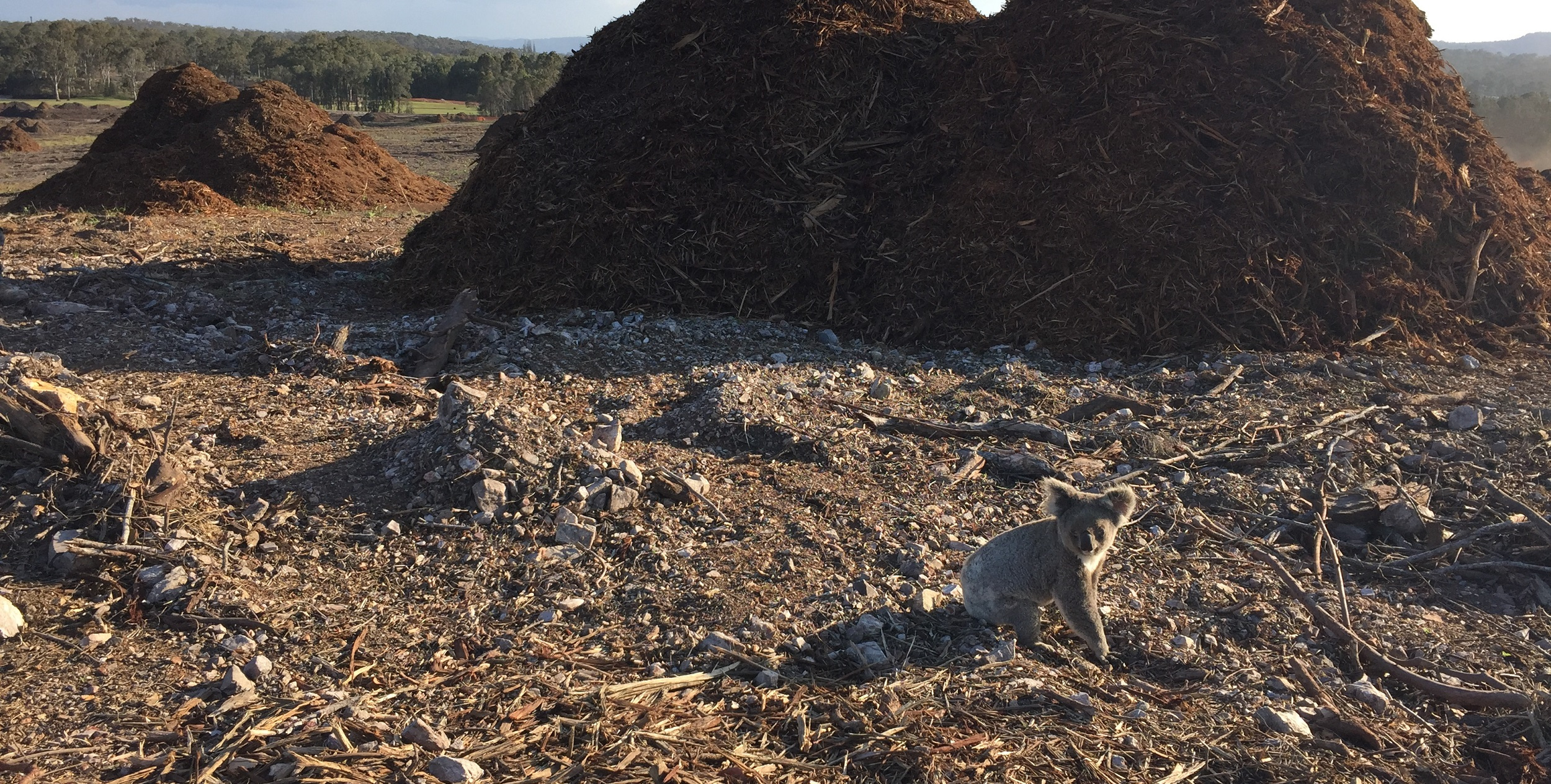
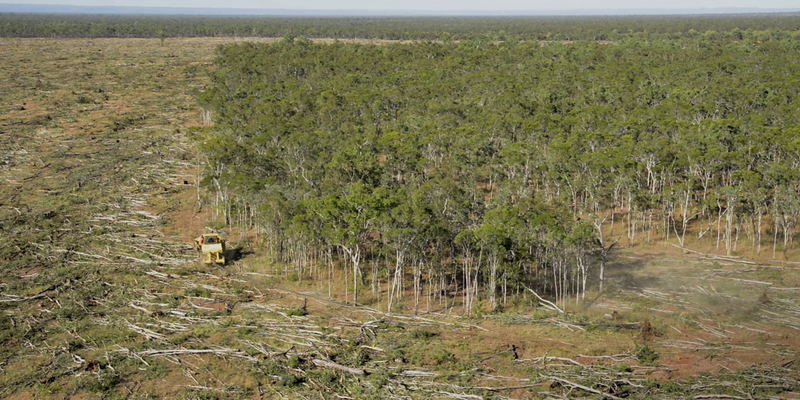
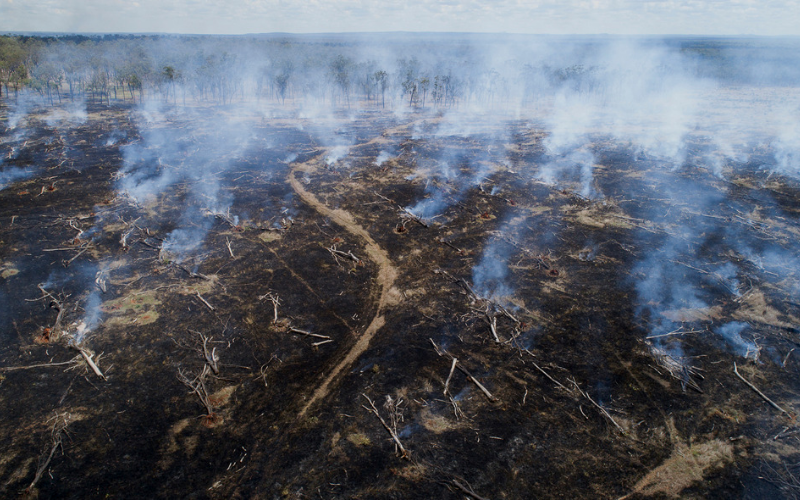
Koala in a deforested area in QLD. Image: Wildcare Australia Inc.
Bulldozers destroy 500,000 ha of forest and bush every year. Image: Olive Vale Station on Cape York Peninsula, QLD, 2014.
Bulldozers drag thick chains through the landscape, snapping trees like matchsticks. This wood isn’t used for anything — it’s burned or left to rot.
2017–present: It’s a list we really don’t want to be included on; Australia’s rate of tree clearing now puts it firmly among the ranks of the global top 10 for deforestation, alongside hotspots like Borneo, the Amazon and the Congo. Over the years, we’ve been successfully challenging mass deforestation proposals in Queensland, WA and the NT, and campaigning for stronger protections for koala habitat in South East Queensland. Thanks to the pressure our campaign has built, we've already pushed the Queensland Parliament to pass historic new deforestation laws. While it’s too early to whether those laws have had the desired effect on the ground, we’ll soon have the power to do just that.
What’s at stake: Australia is in the midst of a biodiversity crisis, with iconic species like the Greater Glider and the koala facing extensive loss of habitat. Deforestation is the main driver, with a football-field-sized area of forest and bushland destroyed across the country every two minutes. Most of this is happening in Queensland, with NSW, WA and the NT also seeing alarming increases.
What we’re up against: Deforestation was something of an unspoken crisis in Australia. In 2017, research demonstrated that there were very low levels of awareness surrounding the issue, and so our first order of action was to blow the lid off deforestation with a public campaign to increase awareness of the issue in Queensland and beyond. Now it's time to tackle the biggest driver of deforestation: beef production.
What we’re doing: In May 2018, the Queensland Parliament passed historic new deforestation laws. It wasn’t an easy road. The LNP, backed by industry lobbyists and other opponents of reform, tried to stop the laws being passed. But thanks to everyday Australians standing up for Queensland’s wildlife, rivers, forests and climate, the laws succeeded. The fight is not over. While the new laws represent good progress, loopholes remain that could allow the bulldozing of forests and bushland to continue. Together, we will keep a close watch on the forests to see whether the laws prove effective at preventing destructive practices. And, we will keep pushing for loopholes in the laws to be closed, safeguarding our forests for generations to come.
We’ve also been working to identify the industries driving deforestation so we can focus our campaigns to pressure them to employ forest-friendly practices. To achieve this we employed a spatial mapping expert to analyse the underlying drivers of the problem in Queensland, where most of the country’s deforestation is taking place. We found that the beef industry is linked to 73% of all deforestation and land clearing in the state.
The data also exposed how much habitat, critical to threatened species like the koala, is being cleared under our woefully inadequate federal environment laws. It’s the first time anyone in Australia has done this kind of mapping and it lays the groundwork for the next phase of our campaign we’ve been developing that focuses on eliminating deforestation from the beef supply chain.
Be part of the next historic victory, today!
Australia needs nature laws that work.
TODAY: What we've learned over more than four decades of campaigning is this: we can’t keep defending areas when they’re under threat. We need to be proactive and secure protections that will safeguard Australia’s natural environment into the future. That’s where the need for new laws comes in.
As we've shown, visionary campaigns like this one are hard, and large‐scale change takes time. The good news? We’ve already made extraordinary progress in our campaign for new national nature laws.
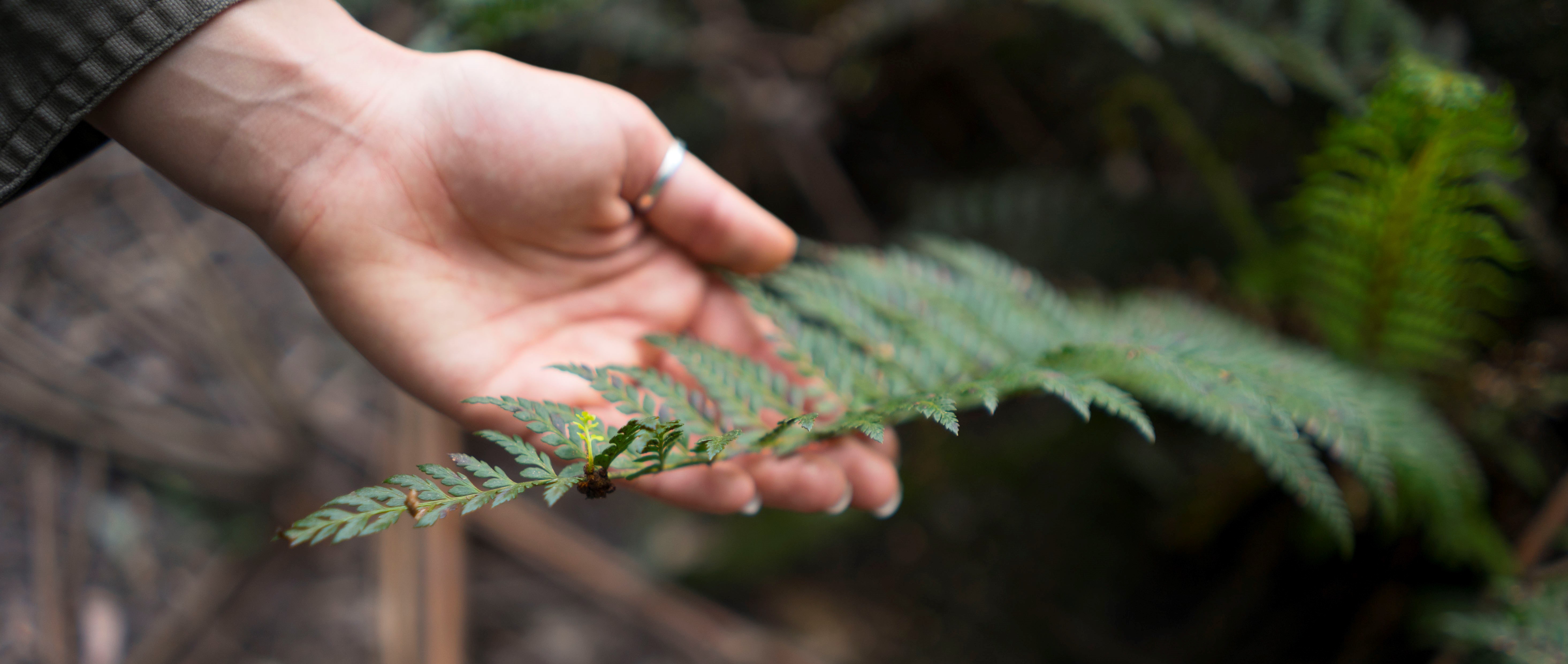
What’s at stake: We know Australians like you want nature protected. But right now, Australia’s national environment laws don’t protect the environment. Old growth forests are being bulldozed and logged. Vital water catchments are being mined and drained by big businesses. The habitats of critically endangered wildlife are being wiped out and species are going extinct before our eyes.
With your support, we can give power back to communities to protect our environment. It's time to secure strong new national nature laws that work and an independent watchdog to enforce the laws.
Will you help us drive momentum and build the movement required to make new nature laws a reality?
Join your local group
The Wilderness Society’s community groups are made up of volunteers all over the country focusing on local community action, as well as wider national issues such as habitat loss and deforestation.
By being involved in your local group, you'll get the chance to contribute to meaningful work that delivers actual results including campaigns, tree plantings, political engagement, community gatherings, forums, door knocks, clean up days and much more.
And when our state and national environment need us, we come together to form an unstoppable force.
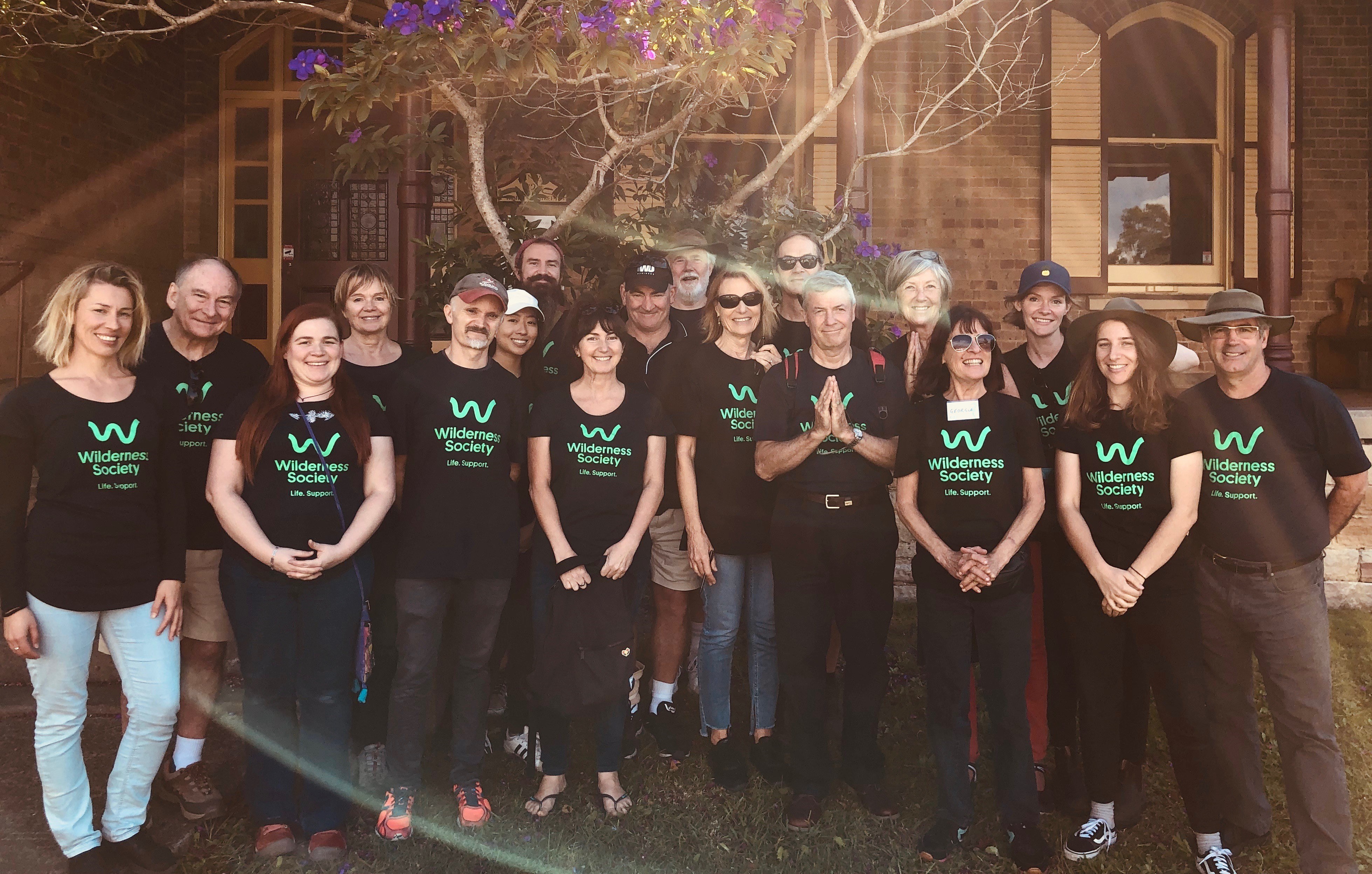
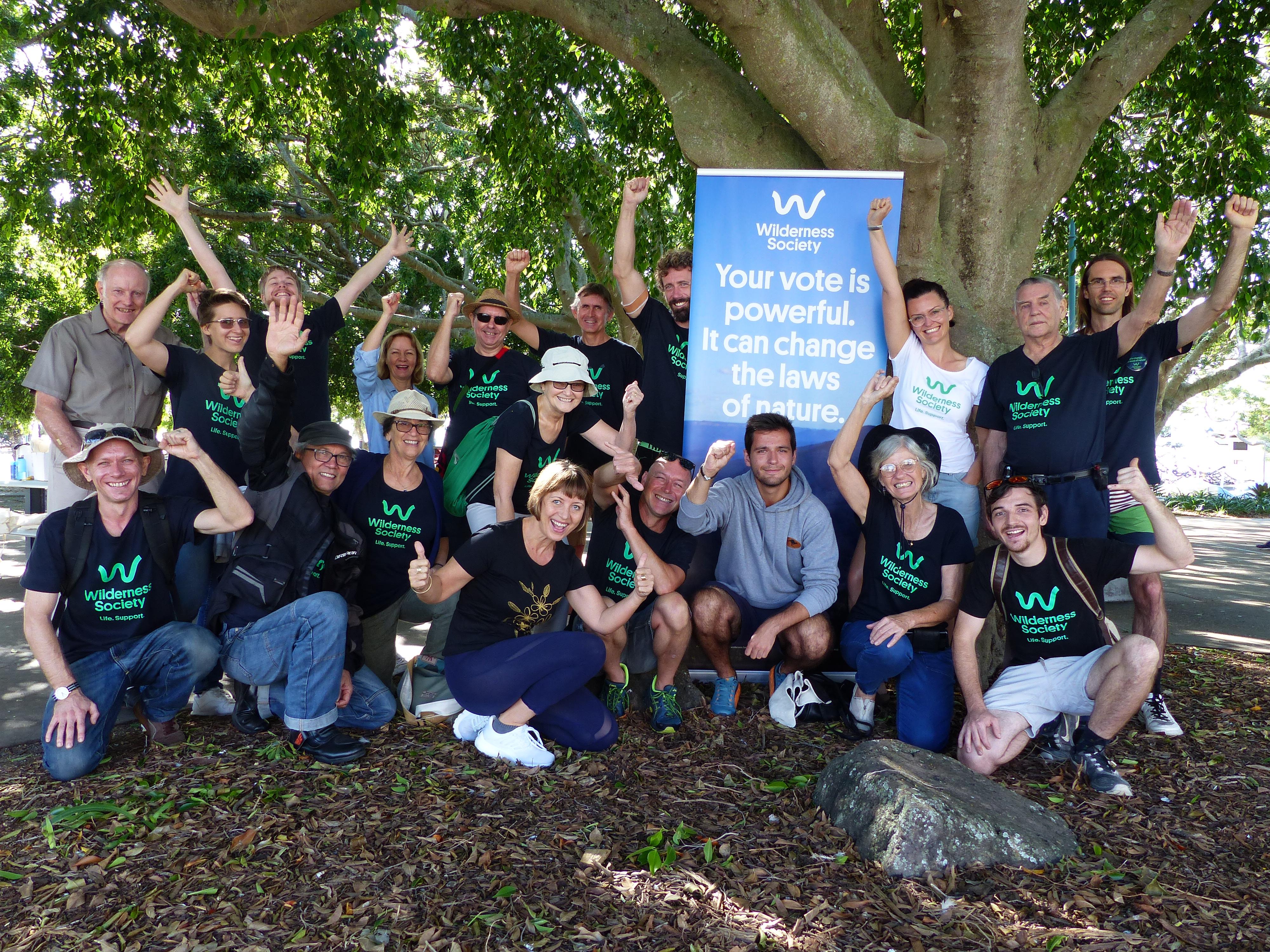
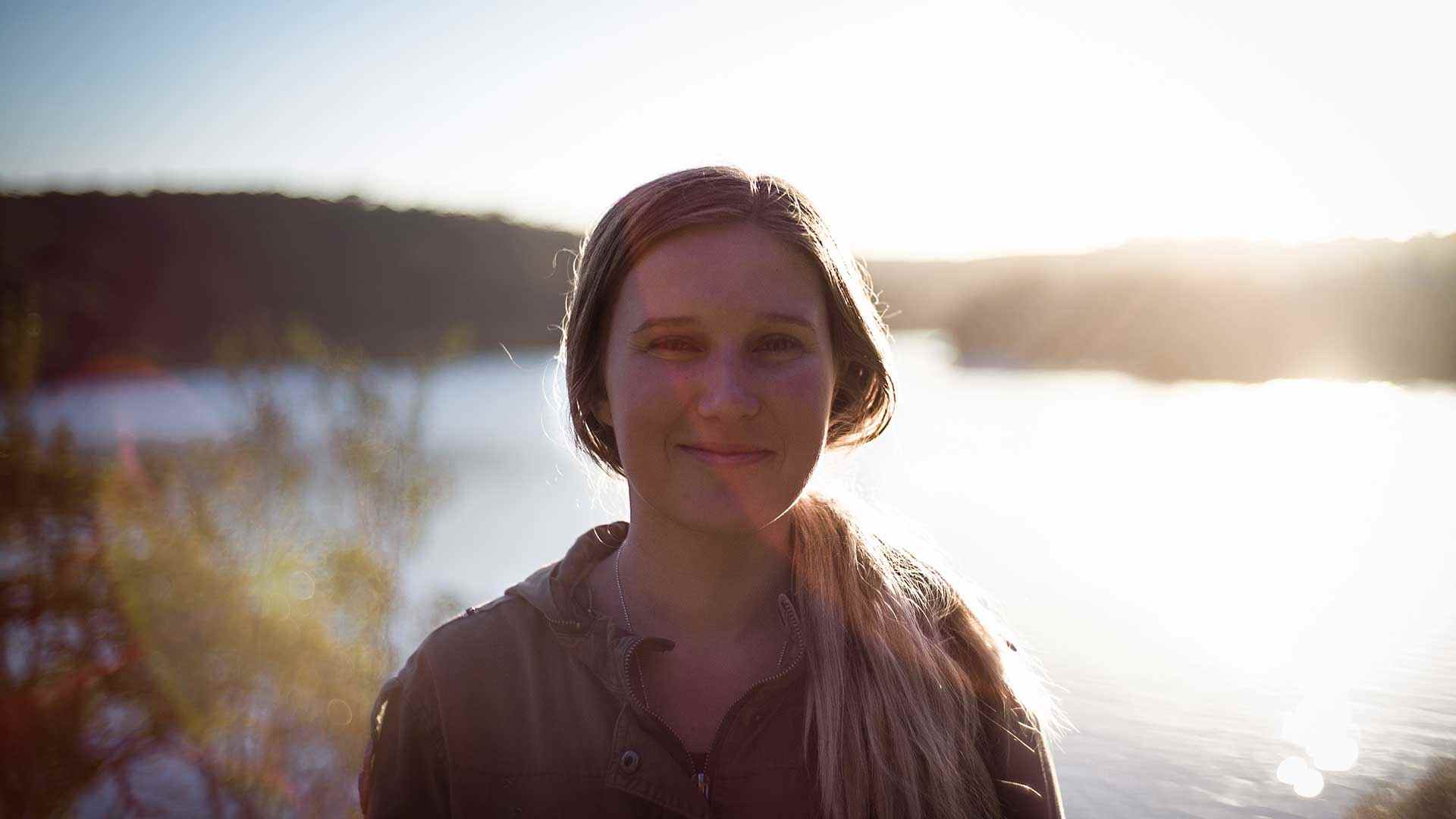
Our volunteers out in the community, talking with Australians about the need for new national nature laws.
"Working on the Change the Laws of Nature Campaign has been a privilege and revelation. Over hundreds of conversations with everyday people, I came to realise there is an agreement that our environment is fragile, unique, and precious and must be protected. As an elderly gentleman said to me while door-knocking, "we don't own the natural world, we hold it in trust for our children." - Jon MaClean, QLD
“Community groups provide practical, hands-on training in working effectively with people, managing community groups and organising community events. We can bring about any social change through proper community organising.” Jasbir, NSW
